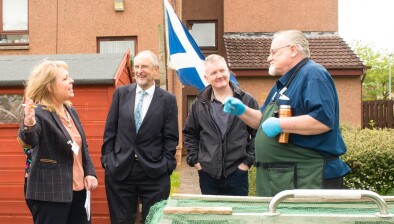Hanover Scotland calls for pragmatic approach to heating innovation to avoid leaving pensioners behind

Angela Currie
Efforts to modernise heating systems across Scotland’s housing stock risk failing the very people they are designed to support unless lived experience is put at the heart of decision-making, Hanover Scotland has warned.
The housing association, which operates more than 200 developments across the country, is using a combination of technology trials, resident feedback and real-world data to challenge top-down assumptions about sustainable heating.
While committed to the transition to net zero, Hanover Scotland says current solutions often don’t account for the unique challenges faced by older residents living in supported environments.
The housing provider is now calling for a more nuanced and realistic approach to heating innovation.
Angela Currie, chief executive of Hanover Scotland, believes a more nuanced and realistic approach to heating innovation is required.
“Net zero goals must not come at the cost of resident wellbeing,” Ms Currie said. “When an 84-year-old is unable to get the level of heat in their home that they need, we’re no longer talking about sustainability, we’re talking about safety.”
At the centre of its approach, Hanover said, is an honest reappraisal of legacy communal heating systems, once considered reliable and cost-effective, but now increasingly out of step with residents’ expectations for control, transparency and value. The housing provider believes it is vital that solutions are considered that limit disruption, avoid stress, and have operating functions that are easy to understand and make sense.
Through a series of live trials, the organisation is equipping homes with performance sensors, enabling data to be collected from multiple flats within a development. This information is then cross-referenced with resident feedback and energy use, helping to expose the gulf between theoretical models and lived experience.
Hanover hopes that its survey information and honest and practical feedback from residents will help it to better understand the thinking of older residents.
Angela argues that assumptions about efficiency are often based on averages and hypotheticals. She added: “What works on paper doesn’t always work in practice, especially for older residents who may be more vulnerable to temperature changes or who use their heating in traditional ways.
“Typically, Air Source Heat Pumps (ASHP) deliver slower heat as the water is heat to an average of between 35 – 55 degrees and provides a more gradual steady heat where electric or gas fuelled heaters deliver instant heat to a higher temperature, often 70 – 80 degrees. All of these variances need to be understood and considered.
“There’s a risk in rushing to adopt solutions that haven’t been designed with our residents or specific housing types in mind.”
According to Hanover, where renewable technologies on new build projects are able to go through a forward planned detailed design and feasibility process, retrofit projects do not have the same luxury. Often, Hanover argues, they have to be more reactive, trying hard to find ways of incorporating new technology into older buildings. This mix, it added, is not always feasible, practical or achievable for some of the following reasons:
- Older electrical supply infrastructure may need upgrading to support ASHP loads.
- Existing heating systems such as electric storage heaters or gas boilers may be incompatible.
- Older radiators in existing facilities are often undersized for lower temperature ASHP’s.
- Sheltered housing often has limited space externally for ASHP units.
- Internal plant room space is restrictive for buffer tanks or hot water cylinders.
- Older buildings may have poor insulation making heat pumps less efficient.
Although widely promoted as a silver bullet, heat pumps have emerged as one of the technologies that require a more thoughtful introduction. While low-carbon and efficient in theory, they are designed to maintain a consistent, low-level background heat – a fundamental shift from traditional systems that switch on and off at scheduled times, or offer a ‘boost’ option. Hanover’s trials show that it’s not the technology itself that poses a problem, but the difficulty some residents face in adapting long-held routines and expectations to a very different way of heating their homes.
Designed to maintain a constant low temperature rather than respond quickly to on/off scheduling or boost commands, they can challenge residents’ expectations and habits.
Angela added: “The technology itself is not the issue. The real challenge lies in helping our residents – many of whom have used the same heating routines for decades – to understand and adapt to a completely different way of managing warmth in their homes.
“This isn’t about rejecting progress. It’s about ensuring new systems are introduced with the right support and context. Our sector should not be a passive recipient of technology – it should lead from the front, shaping solutions that genuinely meet the needs of our residents.”








